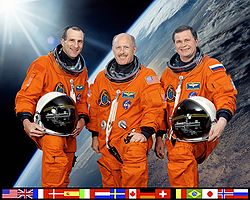Expedition 6
| Expedition 6 | |||
 | |||
| Uppdragsstatistik | |||
|---|---|---|---|
| Rymdstation: | ISS | ||
| Start: | 25 november 2002, 21:59 UTC[1] | ||
| Slut: | 3 maj 2003, 22:43 UTC[1] | ||
| Antal besättningsmedlemmar: | 3 | ||
| Rymdpromenad | |||
| Antal rymdpromenader: | 2 st[1] | ||
| Total tid: | 13 tim 17 min | ||
| Transport | |||
| Uppskjutning: | 24 november 2002, 00:49:47 UTC med STS-113 Endeavour | ||
| Uppskjutningsplats: | Kennedy Space Center[1] | ||
| Landning: | 4 maj 2003, 02:04:25 UTC med Sojuz TMA-1 | ||
| Landningsplats: | Kazakstan | ||
| Kronologi | |||
| |||

Expedition 6 var den 6:e expeditionen till Internationella rymdstationen (ISS). Expeditionen började den 25 november 2002 med att rymdfärjan Endeavour under flygningen STS-113 återvände till jorden med Expedition 5:s besättning. Expedition avslutades den 3 maj 2003 då Sojuz TMA-1 återvände till jorden med Expedition 6:s besättning.
Besättning
| Position | (25 november 2002 - 3 maj 2003) |
|---|---|
| Befälhavare | Hans femte rymdfärd |
| Flygingenjör 1 | Hans tredje rymdfärd |
| Flygingenjör 2 | Hans första rymdfärd |
Referenser
- ^ [a b c d] NASA's Space Station Expedition 6 Arkiverad 16 augusti 2019 hämtat från the Wayback Machine., läst 28 augusti 2016.
Externa länkar
| |||||||||||||||||||
Media som används på denna webbplats
The International Space Station (ISS) Expedition Five patch depicts the Station in its completed configuration and represents the vision of mankind's first step as a permanent human presence in space. The United States and Russian flags are joined together in a Roman numeral V to represent both the nationalities of the crew and the fifth crew to live aboard the ISS. Crew members’ names are shown in the border of this patch. This increment encompasses a new phase in growth for the Station, with three Shuttle crews delivering critical components and building blocks to the ISS. To signify the participation of each crew member, the Shuttle is docked to the Station beneath a constellation of 17 stars symbolizing all those visiting and living aboard Station during this increment.
The International Space Station (ISS) Expedition Seven patch consists of two elliptical orbits which evoke the histories of the two space programs from which the crew is drawn. The Russian and American flags are intersecting, representing the peaceful cooperation of the many countries contributing to the ISS. Two stars indicate the Station's goals of contributing to life on Earth through science and commerce.
The International Space Station (ISS) Expedition 6 crew patch depicts the station orbiting the Earth on its mission of international cooperation and scientific research. The Earth is placed in the center of the patch to emphasize that work conducted aboard this orbiting laboratory is intended to improve life on our home planet. The shape of the Space Station’s orbit symbolizes the role that experience gained from ISS will have on future exploration of our solar system and beyond. The American and Russian flags encircling the Earth represent the native countries of the Expedition 6 crew members, which are just two of the many participant countries contributing to the ISS and committed to the peaceful exploration of space.





